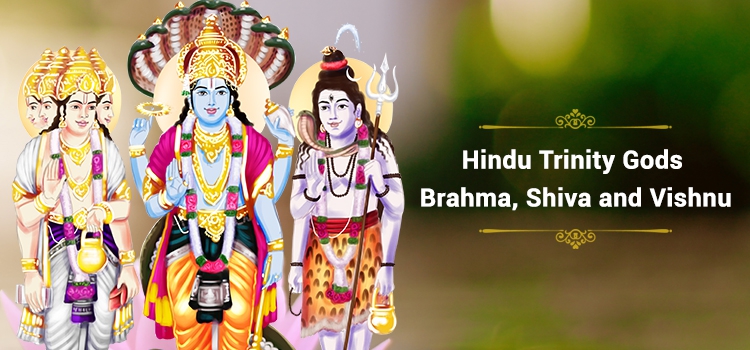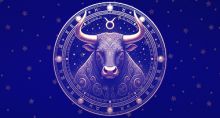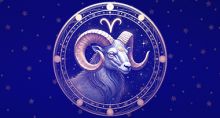Hindu Trinity Gods – Brahma, Shiva, and Vishnu
Brahma, Vishnu, and Shiva form the Trimurtis or Hindu trinity gods in Hinduism. These 3 Hindu Gods are responsible for the world’s creation, preservation, and annihilation. While Vishnu preserves teh Universe, Shiva destroys everything so that it can be created anew. Brahma is the creator who creates everything on earth.
Brahma is not usually worshipped by Hindus due to the fact that he told a lie when there was a supremacy issue between himself and Lord Vishnu. Only a few Brahma temples exist in India. But there are countless temples and followers for Vishnu as well as his avatars, Rama and Krishna. Shiva, too, has many temples and devotees. Vishnu's followers are Vaishnavites, while Shiva’s followers are Shaivites.

The consorts of Brahma, Vishnu, and Shiva are Saraswati, Lakshmi, and Parvati, respectively. They are also called Divine Mothers.
Since ancient times, there have been feuds, often violent, between Shaivites and Vaishnavites. Their conflicting claims are evident in Indian texts like the Mahabharata, but many attempts were also made to reconcile these claims with the idea that both Gods are the same. The Harivamsa says that no distinctions exist between the two.
Brahma is the God of wisdom who created the entire universe. Brahma has red skin, wears robes, and rides a swan. He holds the Vedas in four arms, apart from a spoon, a scepter, a string of beads, a bow, and a water jug. There are many legends about Brahma’s birth.. He supposedly hatched from a floating golden egg. Another myth says that he was born from a lotus that sprang forth from Vishnu’s navel.
When the world faces chaos and ungodliness, Shiva destroys everything. He is also the lord of the creatures. Shiva is depicted in a meditating pose mostly or as the cosmic dancer, Nataraja. A snake lies coiled around his neck. He sits in a yogic pose on the skin of a deer and holds a trident. Shiva’s mount is the bull, Nandi. His sons are Lord Kartikeya and Lord Ganesha. Both of them are also important Gods in their own right.
Initially, Vishnu was not a major God. His mount is Garuda, the eagle, and he reclines on a serpent, Adisesha, in the Milky Ocean. His heavenly abode is Vaikunta. Vishnu holds a discus (Sudarshana chakra), a conch shell (Panchajanya), a lotus, and a mace in his four hands. Vishnu is born on earth as a human, animal, or creature now and then to restore Dharma and destroy evil forces. He is said to have taken 9 major incarnations by now. The 10 most important avatars of Vishnu include Matsya, Kurma, Varaha, Narasimha, Vamana, Parashurama, Rama, Krishna, Balarama, and Kalki. Kalki is yet to manifest. It has been predicted to happen in this current yuga or Kali-yuga.
Brahma
Brahma, the creator God, has already created everything. He will begin again only when the next creation cycle begins. His other names are Ishwara or Mahanshakti. His consort, Saraswati, is the Goddess of wisdom, music, and poetry. She wears white attire and holds a veena in her hands. The swan, a symbol of wisdom, is the mount of both Brahma and Saraswati. Brahma is also called the “Self,” and his symbol is the sound “Om,” which has no form. Brahma is not Brahman, the Universal Consciousness that pervades everything.
Brahma is supposedly reflected in all Hindu gods. He also established a teaching tradition, passing on his knowledge to Sage Narada, who in turn passed it on to Sage Vyasa, who wrote the Mahabharata.
Vishnu
In popular iconography, Vishnu wears a crown and rests on the many-headed snake, Adisesha. A lotus blossom grows from his navel. He is kind, always youthful, and handsome. In his four arms, he holds a mace or gada, called Kaumodaki, a discus, a conch shell, and a lotus.
Vishnu is a deity who seems to have evolved over time from many gods. He was a dwarf (Vamana) in the early Vedic texts, The Rig Veda mentions him only 5 times. Supposedly, he merged with an early Sun God to become a major God.
Vishnu is worshipped in all his incarnations. He is often seen as the personification of the entire Hindu pantheon. Other Gods, including Indra, Agni, and Yama, are represented on different parts of his body. Brahma supposedly emerged from the lotus blossom on Vishnu’s navel. A heavenly carpenter sculpted Lord Jagannath, an incarnation of Vishnu, from a miracle log, along with his brother and sister. Lakshmi, Vishnu’s wife, is the Goddess who bestows wealth and good fortune. She often incarnates on earth during his avatars. Sita, Radha, Andal, etc., are some examples. Rama and Krishna are the most popular avatars of Vishnu. While Rama is the hero of the Ramayana, Krishna plays a key role in the Mahabharata.
Shiva
Lord Shiva completes each cosmic cycle and heralds a new one. Hence, he is a destroyer, preserver, and creator. He has a 3rd eye in the middle of his forehead, which he rarely opens, as it emits intense fire and can reduce anyone to ashes. His hair is matted. His body is coated with ash, and he wears a tiger hide. He wears snakes, like ornaments on his body. He has 4 arms and is often depicted in a meditating pose. He holds a trident and a string of Rudraksha beads in his hands. Shiva is also Adiyogi, who taught the yogic sciences to the Sapta Rishis or 7 seers. He has many forms, like Rudra, Kala Bhairava, Nataraja, Bhikshatanar, etc. Some believe that Hanuman is an avatar of Shiva. As Nataraja, he is the cosmic dancer who both creates and destroys with his dance.
Shiva has the name of Rudra in Vedic poetry. He was a minor god who guarded animals and had a connection with medicinal plants. He has both good and bad aspects. He can both heal and cause sickness. He is mentioned only 3 times in the Rig Veda. Rudra merged with an early fertility deity, Shiva. His fame had grown by the 2nd century B.C., if the numerous stone lingams, Shiva’s symbols, discovered at archaeological sites are any indication. There were Shiva cults, too, in the 2nd century A.D. He became a major deity by the 7th century.
Shiva has a dark side as he is a destroyer, but it has a link to his asceticism, too. Shiva preserves the world while he meditates, in the same way that Vishnu does when he sleeps.
Trimurti Temples
There have been temples dedicated to the Hindu trinity as early as the 6th century CE. Even now, we can find some temples where people worship the Trimurti. They are given below.
· Baroli Trimurti Temple, Chittorgarh, Rajasthan
· Elephanta Caves, Mumbai, Maharashtra
· Mithrananthapuram Trimurti Temple, Thiruvananthapuram
· Prambanan Trimurti Temple, Indonesia
· Savadi Trimurti Temple, Karnataka
· Thripaya Trimurti Temple, Thrissur, Kerala
· Thirumoorthy hills, Tamil Nadu



















